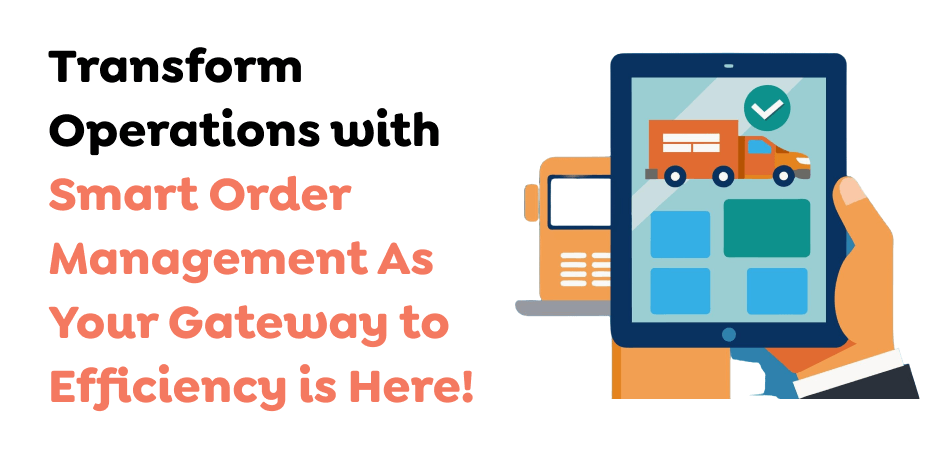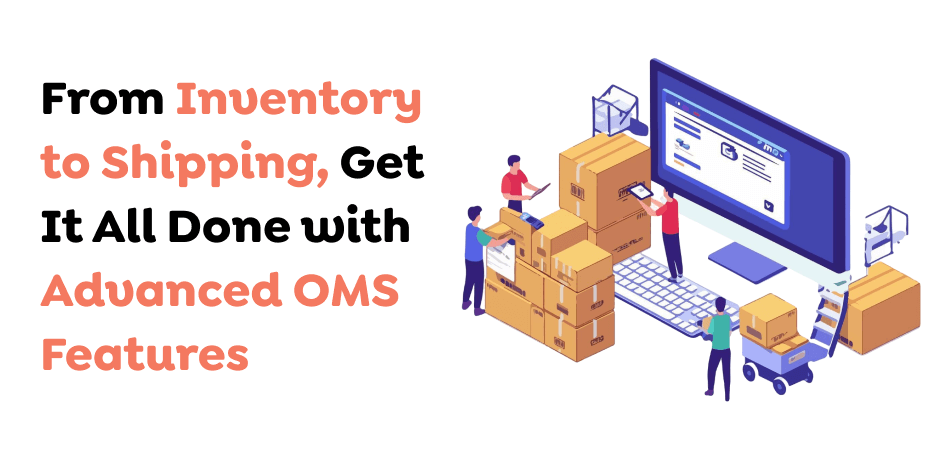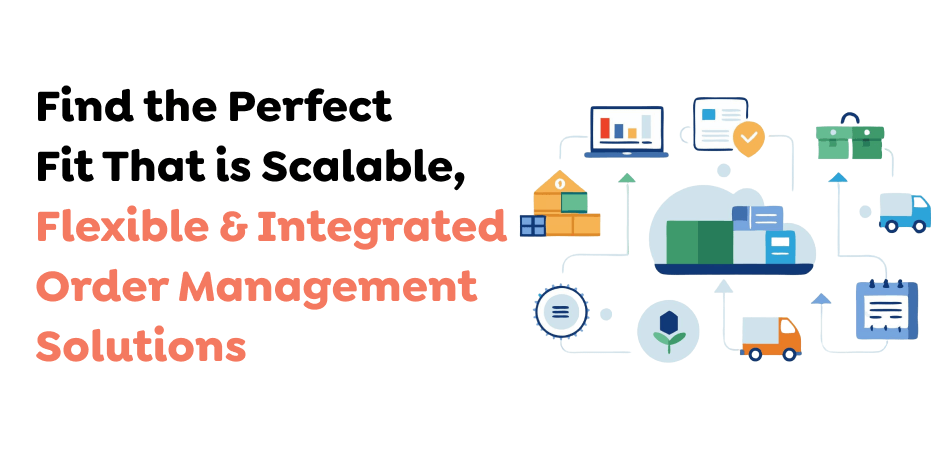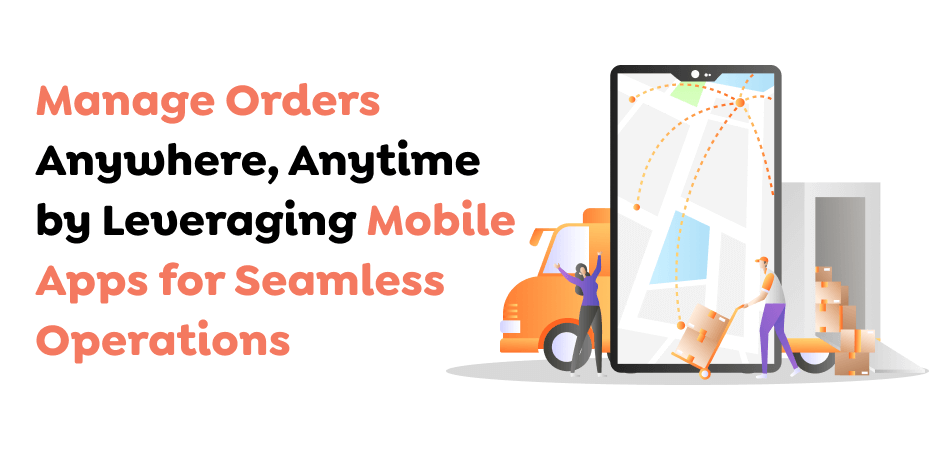Write Us
We are just a call away
[ LET’S TALK AI ]
X
Discover AI-
Powered Solutions
Get ready to explore cutting-edge AI technologies that can transform your workflow!


Order management software (OMS) is a digital tool designed to manage the entire lifecycle of an order automatically, from placing the order to the fulfillment and delivery process. Using it gives businesses real-time visibility on all orders, inventory levels, customer information, and shipping updates so that nothing but coordination across multiple departments results. Most modern order management systems integrate with CRM, ERP, and e-commerce order management systems to manage online and offline sales through one interface.
Such software automates many processes, which helps businesses to improve operational efficiency and reduce human error. It enhances customer satisfaction by processing the order efficiently and tracking it in real-time to get it delivered on time and not delayed. Additionally, it helps to have better inventory management and prevent stockouts or selling too much, an essential factor for securing customers’ trust and credibility.
Just Read : The Ultimate Guide To Hospital Inventory Management Software Development
Business systems that lack efficient order management software face a host of problems. Manually handling orders is susceptible to errors in data entry, miscommunication, and delayed shipments, affecting the customer experience. The more the volume of orders, the more difficult it is for businesses to manage the orders, mainly if they use many sales channels. In addition, poor real-time data hurts the companies’ ability to make accurate demand predictions, leading to overstocking or stock shortages. These inefficiencies lead to sales not being generated, higher operational costs, and strained customer relationships that, in turn, affect profitability and business growth.

This blog would help businesses understand the importance of adopting the best order management systems. It would explain how adopting such a solution would enable automation, reduced errors, and satisfaction through real-time order and inventory visibility. Let’s consider some key features of top software solutions that help businesses create a tool to facilitate increased business productivity, manage several sales channels, and scale operations effectively.
There are several types of OMS, each fitted to a specific business model or operational need. Each type of OMS is tailored to particular business needs, ensuring that companies can optimize operations and enhance customer satisfaction through the right solutions. Take a look on the main types:
This order management software is for business-to-business (B2B) operations. It manages bulk orders and recurring purchases, along with complex pricing structures. It integrates with ERP systems while handling relationships with the supplier, managing large inventories, and managing the purchase orders.
This software is business-to-consumer (B2C) transaction-based and is typically used in e-commerce apps. It is supported by features such as real-time order tracking, shipping integration, and personalized customer experiences in meeting high volume and fast-paced customer expectations.
This OMS has been designed specifically for an online store and integrates with sales channels such as Amazon, Shopify, eBay, and many more. This tool enables hassle-free management of orders from many outlets, always ensuring inventory synchronization, automated shipping, and payment processing. It is about smooth eCommerce operations.
Also Read : Create An Ecommerce App Like Boutiqaat With Comprehensive Guidance
Retail OMS manages in-store and online orders in one place for both physical stores and online platforms. Retail OMS also includes features such as inventory tracking, POS integration, and real-time product availability. All of these features help support omnichannel retail experiences.
Also Read : The Rise Of Saudi Arabia Online Shopping App Revolutionizing Retail in 2025
This software maintains contactless integration with over one channel, which can be websites, mobile apps, stores, and social media sites. Therefore, the unified order visibility allows businesses to provide a seamless and integrated experience to their customers, irrespective of the used channel.
This OMS is especially developed for wholesalers and distributors dealing with bulk orders, warehouse management, and supplier coordination. All the tasks such as purchasing orders, invoicing, and fulfillment workflows are automated within the wholesale order management software to ensure quick response to large-scale orders.
Designed for businesses providing subscription-based products or services, this software manages the recurring orders, renewals, and payment processing. It ensures automated billing and smooth customer experience in subscription services.


Order management software automatically obliterates numerous redundant tasks by automatically registering orders manually. Such an application would help improve the staff’s productivity by keeping them more engaged in activities of strategic importance, thereby accelerating the order processing and, hence, improving productivity. As a result of streamlined workflows, companies can manage higher volumes of orders without compromising quality.
Importantly, it also permits businesses to provide faster order fulfillment and to grant their customers real-time tracking information. This empowers customers who will know each step in the order’s lifecycle. Such transparency allows for building customers’ trust and loyalty. Positive customer experiences result from timely and accurate deliveries, ensuring return business and possible referrals.
Also Read : Achieve Customer Satisfaction Mobile App
Eradicating human error in processing, like with order management software, reduces the risk of data entry mistakes and misplaced orders. Businesses can improve the integrity of data with this accurate data and automatized process, making inventory management much better and giving fewer disagreements about the exactness between orders and stock levels.
Because it has real-time data and complete analytics, a business can make informed decisions, creating a current basis from trends and performance metrics. Order management software offers insights into sales patterns, customer behavior, and stock levels. This way, a business can adapt its real-time strategies to improve the scope for better outputs.
Also Read : Documenting The Future The Power Of HR Document Management Software
As business grows, order volumes typically increase and require a more robust order management system. The order management software allows companies to scale their activities without requiring extensive manual intervention and accommodation of growth without dismantling business performance. It enables businesses to change market demands by expanding reach without holding on to low performance.

When selecting order management software, evaluate your business requirements and priorities, improve the shopping landscape, the size of your operation, the complexity of your order processes, and the types of products you sell. For example, suppose your business has a high volume of online orders. In that case, you’ll need software to handle large quantities efficiently while providing real-time inventory management and automated order processing features. Assessing your needs helps ensure that the chosen software will enhance your operations rather than complicate them. Thus, building a custom work order management software by a professional software development company would be your best decision.
Also Read : Driving Progress The Rise Of Software Development In The Middle East
As your business grows, your order management software should be able to scale accordingly. Look for flexible solutions for increasing order volumes, diverse sales channels, and additional locations. Scalable software means you can quickly change to meet your market’s needs by either entering new markets or launching a new product. A system that grows along with you will save time and resources in the long run as you avoid the many frequent upgrades or replacements.
Also Read : Everything You Need To Know Before Launching Your First Mobile App
Compatibility with existing systems is a preeminent factor in deciding your choice of order management software. Make sure that your order management software can integrate well with your current means like:
ERP systems are fully packaged software designed to operate one or multiple organizational business functions, such as finance, supply chain, manufacturing, and human resource functions. The order management software in the ERP system helps the system run smoothly. The order management software is usually integrated with the following: it provides real-time levels of stock and financial performance and order statuses. This way, all departments are working with the same information. This keeps the orders being processed and fulfilled efficiently and accurately.
CRM platforms focus on the interactions and relations between a company and its customers. They centralized the customer information, including the order history, preferences, and communication logs. With order management software integration, CRMs enhance customer services by providing an order view and allowing a personal touch. Businesses can effectively follow the course of their customers’ interactions, close orders fast, and, in the long term, win loyalty through marketing efforts and follow-ups.
Also Read : AIOPS Platform AI Driven It Operations Revolution
The software’s ease of use is critical in effective deployment across your company. Select an order management system with an intuitive interface so that employees’ learning curve would be lowered as much as possible. Usability simplifies the rapid period of learning with regard to using the software. It shall minimize the training period and maximize the serious usage; hence, the system to be chosen should be requested to provide a demo or trial so you can check whether the interface and features comply with the requirements and tendencies of your team.
The investing cost in the order management software and the return on investment are to be made. Evaluate the revenue model: subscription fees, implementation charges, and other expenditures for training and support. Calculate the benefits such as better efficiency, fewer errors, and higher customer satisfaction, which may be assumed when the expected benefits of order management software increase its value. A well-chosen order management system will save considerable costs and generate revenue. So, indeed, it is a good investment for your business.
Now let’s consider some case studies of companies that have completed and implemented the order management software and have derived benefits from that implementation:

Zalando is the largest European online fashion platform. Because of rapid growth, this company faced challenges in order processing and inventory handling. Advanced order management has enabled Zalando to automate order processing and enhance the visibility of its inventory across multiple warehouses. With this, they achieved higher-order fulfillment speed, thus increasing conversion rates and repeat sales. They will get fast delivery and live tracking, improving the shopping experience. Manual mistakes are reduced, and optimal inventory levels will be achieved through automation, lowering relevant costs.
Also Read : When Ecommerce Meets AI Explore The Perfect Match For Fashion?
Sephora is a global cosmetics chain store. The company wanted to enhance its omnichannel approach, improving its order management through online and offline purchases. So, the company opted for an order management software that integrates with the currently implemented ERP and CRM systems. This could process online orders and in-store pickups more effectively. Customers appreciated the order tracking as well as click-and-collect flexible fulfillment options. Operation streamlined ensured labor costs and inventory turnovers were decreased.
Birchbox, an online beauty product subscription box company, faced the challenge of handling an increasing number of subscribers and order fulfillment. Birchbox streamlined the subscription management and order processing workflows using a complex order management system. With effective order management, Birchbox could upsell and cross-sell orders to increase the average value of an order. With the timely updates by the customer regarding changes in the status of the orders, order delays were minimized, and user retention rates improved. Moreover, automation also eliminated the high operational overhead and optimized inventory management, which led to a low fulfillment cost.
Also Read : Mastering Mobile App Onboarding Seamless User Experience Higher Retention
L.L. Bean is an outdoor gear retailer that aims to optimize order management since the company’s e-commerce sales are increasing. The company invested in an all-encompassing order management system coupled directly with its supply chain and logistics activities. Faster order processing and improved stock visibility allowed L.L. Bean to fulfill customer demands quickly and boost sales. Enhanced order tracking and timely updates kept customers informed, leading to positive shopping experiences. Optimized inventory management reduced excess stock and associated carrying costs, improving overall profitability.
This e-commerce agency leveraged streamlined order management systems to support global sales on platforms like Amazon and Walmart. Their focus on efficient workflows resulted in a high customer retention rate (80%) and consistent monthly revenue of $140,000 without needing paid advertising. This success showcases the importance of a well-integrated order management solution in maintaining customer relationships and scaling operations efficiently.
Also Read : How To Develop An App Like Amazon Learn Here?
A data analytics and AI-based platform built by two friends in Boston helped small businesses automate operational tasks and optimize order management. With over 50 businesses engaging with their free assessment tool shortly after launch, they generated $23,000 in revenue in just one month. Their case highlights how automating back-end processes can quickly improve profitability and scale.
Also Read : Revolutionizing Tourism The Impact Of Artificial Intelligence App
This SaaS platform was initially developed to automate order and data management tasks for internal Shopify brands and now serves over 5,000 businesses. The company grew into an eight-figure business, showing how centralizing order, inventory, and analytics data into a unified platform can enable businesses to make data-driven decisions and significantly increase revenue streams.
These cases illustrate the transformative impact of adopting order management software beyond operational efficiency, leading to strategic insights and long-term customer satisfaction.
Mobile apps have turned out to be one of the most essential tools for order management companies, and they keep providing businesses with options for flexibility, efficiency, and more vigorous customer engagement. Mobile apps instantly make data and operations available on the move such that employees and customers can easily manage orders conveniently, improving the order fulfillment process.

The cost to develop a mobile app can be widely varied based on complexity, features, and platforms such as iOS, Android, or a combination of both. The simpler order management apps are closer to $30,000 to $50,000, while more complex solutions encompass integrations, custom features, and advanced analytics, easily spilling over into those wide ranges. Add app maintenance, updates, and cloud storage costs to the top limit.
Long-term investment in mobile applications for an order management system software offer efficiency gains, increase sales, and therefore, loyal customers which means that it can be one of the most crucial investments of modern business.
Also Read : Meet Ai How To Boost Sales In Retail And Enhance Customer Satisfication

While studying the basic principles of order management software or OMS, we learned how it enhances business functionality. We learned about the key features such as automated order processing, inventory management, shipping coordination, and customer relationship management integration. All these avoid critical errors in the business processes, bring about efficiency, and increase consumer satisfaction. The blog also touched on the importance of mobile apps in OMS, enabling real-time tracking and remote management. Moreover, we provided insights on choosing the right software by evaluating scalability, flexibility, integration with ERP/CRM systems, and return on investment (ROI). Real-life success stories demonstrated how businesses achieved growth, reduced costs, and boosted customer retention through OMS adoption.
To stay competitive and optimize operations, businesses are encouraged to explore OMS solutions. Techugo, a reputable mobile app development company in USA, can assist in building custom apps that complement order management systems, ensuring seamless workflows and improved business performance.
Get in touch with Techugo to bring your project to life. Our experts can help build custom solutions tailored to your business needs, ensuring seamless order processing and enhanced performance. Let’s collaborate and take your business to the next level!
Write Us
sales@techugo.comOr fill this form